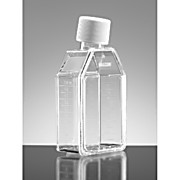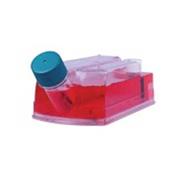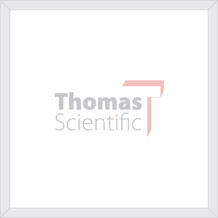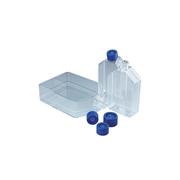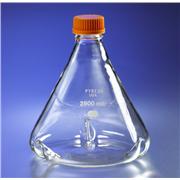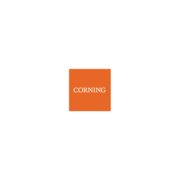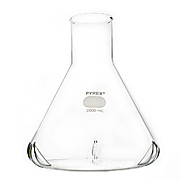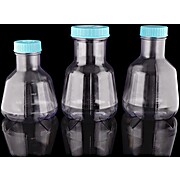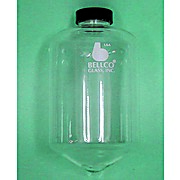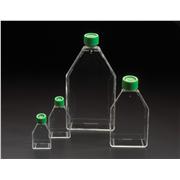Cell Culture Flasks
Cell culture flasks and bottles are ideal for growing and maintaining cells in culture. Cell culture flasks are typically manufactured from borosilicate glass, polystyrene, and polycarbonate, suitable for a range of laboratory applications. Various sizes are available from Thomas Scientific, from 25ml to 1L and a number of T flasks. Tissue culture flasks are suitable for various applications within the lab, including cell biology, microbiology, biochemistry, and genetics. The availability of various shapes and designs means some flasks may also have additional features, such as filters or vented caps, to assist the exchange of gases and maintain the proper environment for cell growth. T25 flasks offer the ideal surface and ancillary options. All tissue culture flasks allow for the attachment and growth of cells and the exchange of gases.
-
Extra deep baffle indents on the lower outside edge of the flask to maximize oxygen transfer to the culture medium when used on an orbital shaker. Delong style neck is made to fit stainless steel or plastic closures, while the longer neck reduces the amount of splashing that would reach the closure.
-
Fernbach Flask, Baffled, Plain Neck
Ace GlassFernbach style culture flask with long style straight neck for either plastic or stainless steel closures, see Ace 3917 and 3918 product families. The bottom of the flask is triple baffled to achieve maximim oxygen transfer to the culture medium. Caution! Do not place on direct heat source.
-
 Falcon® Cell Culture Flasks
Corning
Falcon® Cell Culture Flasks
CorningVacuum-gas plasma tissue culture treatment provides consistent cell attachment, spreading, and growth Choose standard tissue culture, Corning® Primaria™, or not tissue culture-treated polystyrene growth surfaces to meet your individual cell culture requirements…
-
-
Fernbach Flask, Baffled, Beaded Neck
Ace GlassFernbach style culture flask with wide-mouth and beaded neck. The flask is triple baffled on the bottom edges to achieve maximum oxygen transfer to the culture medium. 63mm ID beaded neck accepts cotton plugs or rubber stoppers.
-
 BioFactory™ Systems
NEST Scientific USA
BioFactory™ Systems
NEST Scientific USANest BioFactory™ Systems are compact, multi-layer, single-use cell culture systems designed for easy scale-up cell culture applications, such as production of vaccines, monoclonal antibodies or pharmaceuticals. Versatile, easy-to-use systems for small scale research or commercial production…
-
Manufactured from type 1 class A borosilicate glass and designed for culturing organisms requiring a large surface area-to-volume ratio. The flask has a DeLong style neck and uses a 38mm SST closure 2005-00038 (sold separately).
-
CELLine™ Flasks
DWK Life Sciences (Wheaton)CELLine™ flasks are easy to use high density cell culture flasks. Their unique dual membrane system allows for less culture handling, longer run times, and super concentrated cells and supernatant. The upper compartment stores bulk cell culture media that feeds the culture during operation…
-
Manufactured from type 1 class A borosilicate glass and designed for culturing organisms requiring a large surface area-to-volume ratio. The flask is supplied with a GL45 blue polypropylene linerless screw cap and pouring ring. Dimensions: 200 x 157mm
-
Celltreat® Tissue Culture Flask
DenvilleThe Celltreat 75 sq-cm tissue culture flask contains a stable hydrophilic surface that ensures uniform cell attachment. Zip closure bag keeps the contents of the bag safe and secure by preventing any leakages. The large canted neck gives smooth access to the entire flask surface. Thick durable…
-
Shake Flasks are the basic tool for growth studies of aerobic microbial cultures and have rigidly controlled baffle angles and depths to promote optimal oxygen transfer while reducing vortex formation. Designed for use with Orbital Shakers.
-
PYREX Crystallizing Dishes
CorningWith reinforced rims, fire-polished to reduce chipping Will withstand repeated sterilization (wet or dry) Ideal for storage and crystallization
-
PYREX Low Form Culture Flasks
CorningMaximum o.d. 250 mm; height 195 mm Takes number 6 1/2 rubber stopper Capacity 2,500 mL
-
Nunclon Treated Tissue Culture Flasks, Filter Cap
Thermo Scientific NuncSpecially designed for laboratories where extra security against contamination is necessary Sterile Cap contains 0.22 mm hydrophobic filter, which prevents wetting and bacteria from growing through membrane while allowing quick, stable buffering in aCO2 incubator. Filter…
-
Flasks are ideal for preliminary fermentation and bacterial growth studies Delong style neck and three side baffles Borosilicate glass type 1, class A Closures sold separately*
-
PYREX Baffled Culture Flask
CorningScrew cap This wide mouth flask is designed for culturing organisms requiring a large surface area to volume ratio. Triple baffled on the bottom outside edges to achieve maximal oxygen transfer to culture medium. Supplied with GL45 orange polypropylene cap.
-
*NEW* G-Rex®500M-TF (closed system with open access), Sterile Fluid Path
Wilson Wolf Manufacturing500cm² gas permeable membrane surface area with 5000 mL media capacity. Closed system with semi-automated liquid handling in conjunction with GatheRex Pump. Removable cap designed for tumor fragment addition. Expand 250 million cells into between 15 to 20 billion cells in about 10 days with NO…
-
Corning PureCoat amine (positively charged) and carboxyl (negatively charged) surfaces provide improved cell attachment, faster cell proliferation, and enhanced recovery post-thaw over standard TC surfaces. These surfaces function with a broad range of primary, transfected, transformed, and…
-
Nephelo Flask, No Baffles, Screw Cap
Ace GlassNephelo culture flask with side port and angled side arm cuvette for standard Nephelometers and spectrophotometers. Supplied with 38-430 phenolic top cap and 18-415 clean-out port cap.
-
Trypsinizing flask for converting of homogenous tissue samples into cell suspensions by digestion of connective tissue. Side port has dam below the side arm to prevent undigested tissue from being poured out while decanting cells. Flask has GPI thread top and side arm cap. The three extra deep,…
-
 PYREX Fernbach Culture Flasks
Corning
PYREX Fernbach Culture Flasks
CorningDesigned for culturing organisms requiring a large surface area to volume ratio Can also be used in serum production Takes stopper size 13 Thomas number 4912L15 features a triple baffle on the bottom outside edges to achieve maximum oxygen transfer to culture medium. NOTE: do…
-
Erlenmeyer Flasks (with Baffles)
NEST Scientific USAHigh-efficiency, large-volume culture flasks allow cells to show strong viability with large expression amount of proteins in the culture of mammalian cells and insect cells. During the culturing process, the use rate of the shaker is significantly increased, and the survival rate and…
-
Manufactured from type 1 class A borosilicate glass and supplied with 38m-415 black phenolic rubber lined screw cap
-
Advanced TC T-75 Tissue Culture Flask
Greiner Bio-OneAdvanced TC™ polymer modification for fastidious or sensitive adherent cells Free of detectable DNase, RNase, human DNA Non-Pyrogenic, non-cytotoxic Growth area: 75 cm 2 Total Volume: 250 mL Working volume: 15 ml - 38 mL With blue standard screw cap Sterile …
-
Shake Flasks are the basic tool for growth studies of aerobic microbial cultures and have rigidly controlled baffle angles and depths to promote optimal oxygen transfer while reducing vortex formation. Designed for use with Orbital Shakers.
-
 Suspension Culture Flasks
Celltreat Scientific
Suspension Culture Flasks
Celltreat ScientificCELLTREAT Suspension Culture flasks are manufactured under the most stringent conditions and include a 100% integrity test to assure the reliability with your tissue and cell culture work. Class 100,000 clean room, USP class VI virgin polystyrene, and ISO 9001:2000 quality management systems all…
-
Shake Flasks are the basic tool for growth studies of aerobic microbial cultures and have rigidly controlled baffle angles and depths to promote optimal oxygen transfer while reducing vortex formation. Designed for use with Orbital Shakers.
-
Manufactured from type 1 class A borosilicage glass with cleanout port and depressed sidearm. Supplied with black phenolic rubber lined 38-415 center cap and 18-415 sidearm cap.
-
Cell culture shake flask with three outside edge baffles. Baffles are deeper than standard flask to enhance mixing and oxygen transfer to media. Flask has a long style neck to accomodate either plastic or stainless steel closures.
-
Flasks are ideal for preliminary fermentation and bacterial growth studies Delong style neck and three side baffles Borosilicate glass type 1, class A Closures sold separately*
-
G-Rex® Cap, 48mm Teal, Vented, Gamma Irradiated
Wilson Wolf ManufacturingReplacement vent filter cap for G-Rex®10M, 100, 100M or 500M open system products. [GAMMA IRRADIATED. For non-clinical, non-therapeutic, research use only. No certificate provided.]





